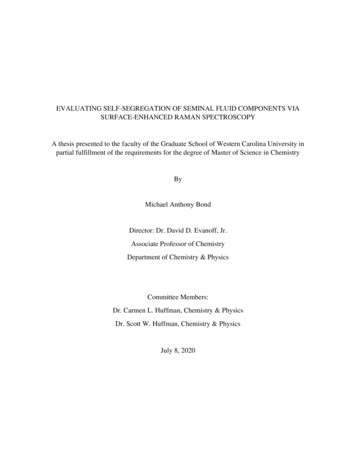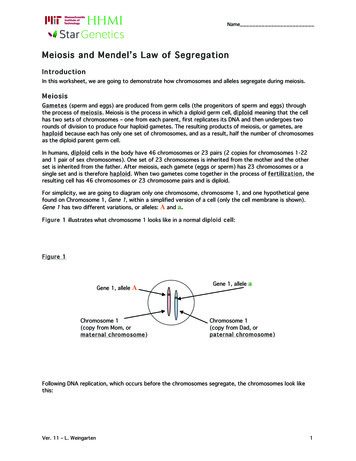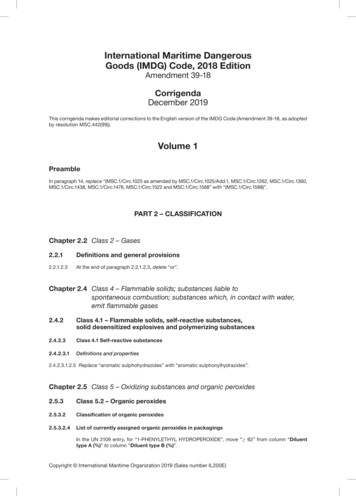
Transcription
EVALUATING SELF-SEGREGATION OF SEMINAL FLUID COMPONENTS VIASURFACE-ENHANCED RAMAN SPECTROSCOPYA thesis presented to the faculty of the Graduate School of Western Carolina University inpartial fulfillment of the requirements for the degree of Master of Science in ChemistryByMichael Anthony BondDirector: Dr. David D. Evanoff, Jr.Associate Professor of ChemistryDepartment of Chemistry & PhysicsCommittee Members:Dr. Carmen L. Huffman, Chemistry & PhysicsDr. Scott W. Huffman, Chemistry & PhysicsJuly 8, 2020
ACKNOWLEDGEMENTSI would like to thank my advisor Dr. Evanoff for all of the guidance he has given me overthe course of this project. I am extremely grateful for the privilege to work under an advisor whogoes about his work with such enthusiasm and dedication. As I continue my chemistry career, Iwill strive to approach challenges with the same levels of insight and patience that he has shown.I would also like to thank my thesis committee members, Dr. Carmen Huffman and Dr. ScottHuffman, for all of the valuable lessons and perspectives they taught me both in class and duringcommittee meetings. I extend my gratitude to the rest of the faculty and staff of the Chemistryand Physics Department, for their many contributions to the great experience I have had atWestern.I also want to thank my extended family, my parents, my brother Kyle, and my dog Mimifor all of the emotional (and financial) support, and for always believing in me. A very specialthank you to David Song, for all of the support you’ve given me. I would also like to thank myfriends in the graduate Chemistry program at Western, especially Jesse Ingham, CeciliaBaumgardner, and Daniel Free, who helped make this a wonderful past two years.I want to again thank everyone above for the resilience, reliability, and understanding theyhave all shown during the ongoing COVID-19 pandemic; the completion of this document wouldnot have been possible without all of you.Lastly, I would like to thank the National Institute of Justice for grant (2015-NE-BXK003), and the National Science Foundation (CHE-1040163) for funding the Raman spectrometer.ii
TABLE OF CONTENTSLIST OF TABLES .vLIST OF FIGURES . viLIST OF ABBREVIATIONS . ixABSTRACT.xCHAPTER 1: BACKGROUND .11.1 Confirmatory testing of seminal fluid .11.2 Raman spectroscopy .31.2.1 Fundamentals .31.2.2 Applications in forensics.51.3 Surface enhanced Raman spectroscopy (SERS) .61.3.1 Fundamentals .61.3.1 Silver-coated swabs .91.3.3 Percolation threshold .101.4 Complex stain analysis .121.4.1 Coffee ring effect .141.4.2 Stains of heterogeneous mixtures .17CHAPTER 2: INTRODUCTION TO RESEARCH .19CHAPTER 3: EXPERIMENTAL.213.1 Materials .213.2 Instrumentation .213.3 Silver layer synthesis .223.3.1 Thermally-grown layers .223.3.2 Chemically-grown layers .233.4 Four-point probe measurements .243.5 Contact angle hysteresis measurements .263.6 Semen simulant formation .283.7 Raman spectra acquisition .29CHAPTER 4: RESULTS AND DISCUSSION .32iii
4.1 Percolation threshold of silver on nylon .324.1.1 Thermally-grown silver .324.1.2 Chemically-grown silver .354.2 Contact angle hysteresis measurements .384.3 Raman and SERS spectra .404.3.1 Urea, phenylalanine, and choline chloride .404.3.2 Semen simulant .454.3.2.1 Simulant on non-percolated thermally-grown silver .464.3.2.2 Simulant on percolated thermally-grown silver .494.3.2.3 Simulant on non-percolated chemically-grown silver .534.3.2.4 Simulant on percolated chemically-grown silver .564.3.2.5 Simulant on bare nylon .594.3.3 Semen.624.3.3.1 Semen on non-percolated chemically-grown silver .644.3.3.2 Semen on percolated chemically-grown silver .694.4 Inter-substrate fitting comparisons .734.5 Stain spreading on silver surfaces .774.6 Comparison of semen spectra to previous studies .84CHAPTER 5: CONCLUSIONS AND FUTURE DIRECTIONS .93CHAPTER 6: REFERENCES .96APPENDIX .102A.1 Representative simulant spectra .102A.2 All semen spectra .105A.2.1 Semen on non-percolated chemically-grown silver .105A.2.2 Semen on percolated chemically-grown silver .106A.3 Alternate fittings .107A.3.1 Fitting simulant data to 713 cm-1 mode .107A.3.2 Fitting semen data to 1000 cm-1 mode .112A.4 Comparison of semen SERS spectra with a previous study .114A.5 Four-point probe measurement statistics .115iv
LIST OF TABLESTable 1. Concentrations and Raman modes of interest for urea, phenylalanine, and cholinechloride for simulant. .29Table 2. Contact angle hysteresis averages, standard deviation, and coefficients of variation forbare nylon, chemically and thermally-grown non-percolated and percolated silver layers onnylon. .38Table 3. Analytical Enhancement Factors for each substrate with respect to the 713cm-1 modefrom choline chloride in simulant stains .44Table 4. Peak-to-peak distances for curves of Figure 39 .77Table 5. changes in areas of stains on bare nylon approximated as ellipsoids .80Table 6. changes in areas of stains on non-percolated chemically-grown silver approximated asellipsoids .80Table 7. changes in areas of stains on percolated chemically-grown silver approximated asellipsoids .80Table 8. changes in areas of stains on percolated thermally-grown silver approximated asellipsoids .81Table 9. 2-tailed T-tests for simulant and choline chloride stains .82Table A1. Comparison of residuals between semen spectra collected on AgNP-coated swab .114Table A2. Comparison of residuals between semen spectra collected in a previous study andsemen spectra taken in this study .114Table A3. Statistical values for thermally-grown silver layers .115Table A4. Statistical values for chemically-grown silver layers .116v
LIST OF FIGURESFigure 1. Presumptive and confirmatory tests for bodily fluids .2Figure 2. Jablonski diagrams for Rayleigh scattering, Stokes Raman scattering, and anti-StokesRaman scattering. .4Figure 3. Dielectric function dependence on wavelength for silver .8Figure 4. Surface enhancement and hot spot arising from plasmon oscillations in adjacent silvernanoparticles .9Figure 5. AgNP-coated nylon swab .10Figure 6. Silver layers grown onto nylon before percolation and after percolation .11Figure 7. Spectra taken at four different locations along a semen stain collected on a AgNPcoated swab .13Figure 8. Stain formation from a drying sessile droplet on a hydrophilic surface and on ahydrophobic surface .16Figure 9. Schematic of thermal evaporator .23Figure 10. Schematic of four-point probe .26Figure 11. Static and dynamic contact angle schematics .27Figure 12. Rotating stage for contact angle hysteresis measurements with free-body diagram of awater droplet on a tilting substrate .28Figure 13. Conductance vs layer thickness for thermally-grown silver layers on nylon .34Figure 14. Conductance vs growth time for chemically-grown silver layers on nylon. .36Figure 15. Normal vs SERS Raman spectrum of urea .41Figure 16. Normal vs SERS Raman spectrum of phenylalanine .42Figure 17. Normal vs SERS Raman spectrum of choline chloride, compared to normal Ramanspectrum of nylon .42Figure 18. Simulant droplet before and after drying on a silver substrate .46Figure 19. Top-down view of simulant stain formed on non-percolated thermally-grown silveron nylon. .47Figure 20. Peak areas of deconvoluted components of urea, phenylalanine, and choline chloridefrom the 1000 cm-1 mode of simulant SERS spectra on a non-percolated thermally-grown silver.48vi
Figure 21. Side view of a simulant stain formed on percolated thermally-grown silver on nylon.49Figure 22. Peak areas of deconvoluted components of urea, phenylalanine, and choline chloridefrom the 1000 cm-1 mode of simulant SERS spectra on percolated thermally-grown silver .50Figure 23. PCA of simulant on percolated chemically-grown silver .52Figure 24. Top-down view of simulant stain on non-percolated chemically-grown silver .53Figure 25. Peak areas of deconvoluted components of urea, phenylalanine, and choline chloridefrom the 1000 cm-1 mode of simulant SERS spectra on non-percolated chemically-grown silver.55Figure 26. Top-down view of simulant stain on percolated chemically-grown silver .56Figure 27. Peak areas of deconvoluted components of urea, phenylalanine, and choline chloridefrom the 1000 cm-1 mode of simulant SERS spectra on percolated chemically-grown silver .58Figure 28. Simulant stain on bare nylon .60Figure 29. Deconvoluted components of urea, phenylalanine, and choline chloride from the1000 cm-1 mode of the length of simulant spectra on bare nylon .61Figure 30. Top-down view of semen stains on nylon before and after AgNPs added .63Figure 31. Top-down view of semen stain on non-percolated chemically-grown silver, withadditional AgNPs added to the stain for further signal enhancement .64Figure 32. Peak areas of deconvoluted components of urea, phenylalanine, and choline from the713 cm-1 mode of semen SERS spectra on non-percolated chemically-grown silver. .66Figure 33. PCA of semen on non-percolated chemically-grown silver .68Figure 34. Top-down view of semen stain on percolated chemically-grown silver, withadditional AgNPs added to the stain for further signal enhancement. .69Figure 35. Peak areas of deconvoluted components of urea, phenylalanine, and choline chloridefrom the 713 cm-1 mode of semen SERS spectra on percolated chemically-grown silver .70Figure 36. PCA of semen on percolated chemically-grown silver .72Figure 37. Average semen spectra from clusters in Figure 36 Panel A .73Figure 38. Comparisons of normalized peak area curves from each substrate .75Figure 39. Comparisons of simulant fitting component sums to semen component sums .77Figure 40. Proposed reactive droplet spreading mechanism.79Figure 41. Progression of spreading of a 20 μL droplet of choline chloride on non-percolatedchemically-grown silver.81Figure 42. Comparisons between SERS semen spectra taken in a previous study to SERS semenspectra taken in this study on non-percolated chemically-grown silver .85vii
Figure 43. Comparisons between SERS semen spectra taken in a previous study to SERS semenspectra taken in this study on percolated chemically-grown silver. .86Figure 44. PCA of semen on non-percolated chemically-grown silver compared to SERS swabsemen spectra collected by Burleson .90Figure 45. PCA of semen on percolated chemically-grown silver compared to SERS swabsemen spectra collected by Burleson .91Figure A1. Representative spectra of simulant on bare nylon: outside edge and center .102Figure A2. Representative spectra of simulant on bare nylon: outside edge and inside edge .102Figure A3. Representative spectra of simulant on non-percolated thermally-grown silver .103Figure A4. Representative spectra of simulant on percolated thermally-grown silver .103Figure A5. Representative spectra of simulant on non-percolated chemically-grown silver .104Figure A6. Representative spectra of simulant on percolated chemically-grown silver .104Figure A7. All spectra of semen on non-percolated chemically-grown silver .105Figure A8. All spectra of semen on percolated chemically-grown silver .106Figure A9. Peak areas of deconvoluted components of urea, phenylalanine
A thesis presented to the faculty of the Graduate School of Western Carolina University in partial fulfillment of the requirements for the degree of Master of Science in Chemistry By Michael Anthony Bond Director: Dr. David D. Evanoff, Jr. Associate Professor of Chemistry










